Organizational Behaviour Report: Culture, Motivation, Teams, M&S
VerifiedAdded on 2023/01/12
|11
|3233
|64
Report
AI Summary
This report provides a comprehensive analysis of organizational behaviour, exploring how organizational culture, power dynamics, and politics influence performance within a company. It delves into various motivational theories, including content and process theories, examining their impact on employee engagement and goal achievement. Furthermore, the report contrasts effective and ineffective team dynamics, referencing Tuckman's theory and Belbin's typology to illustrate team development and role allocation. Finally, it discusses key concepts and philosophies related to organizational behaviour, applying them to a business situation within Mark & Spencer (M&S), and examining the application of Path Goal theory. The report aims to provide insights into how these elements collectively shape an organization's success.
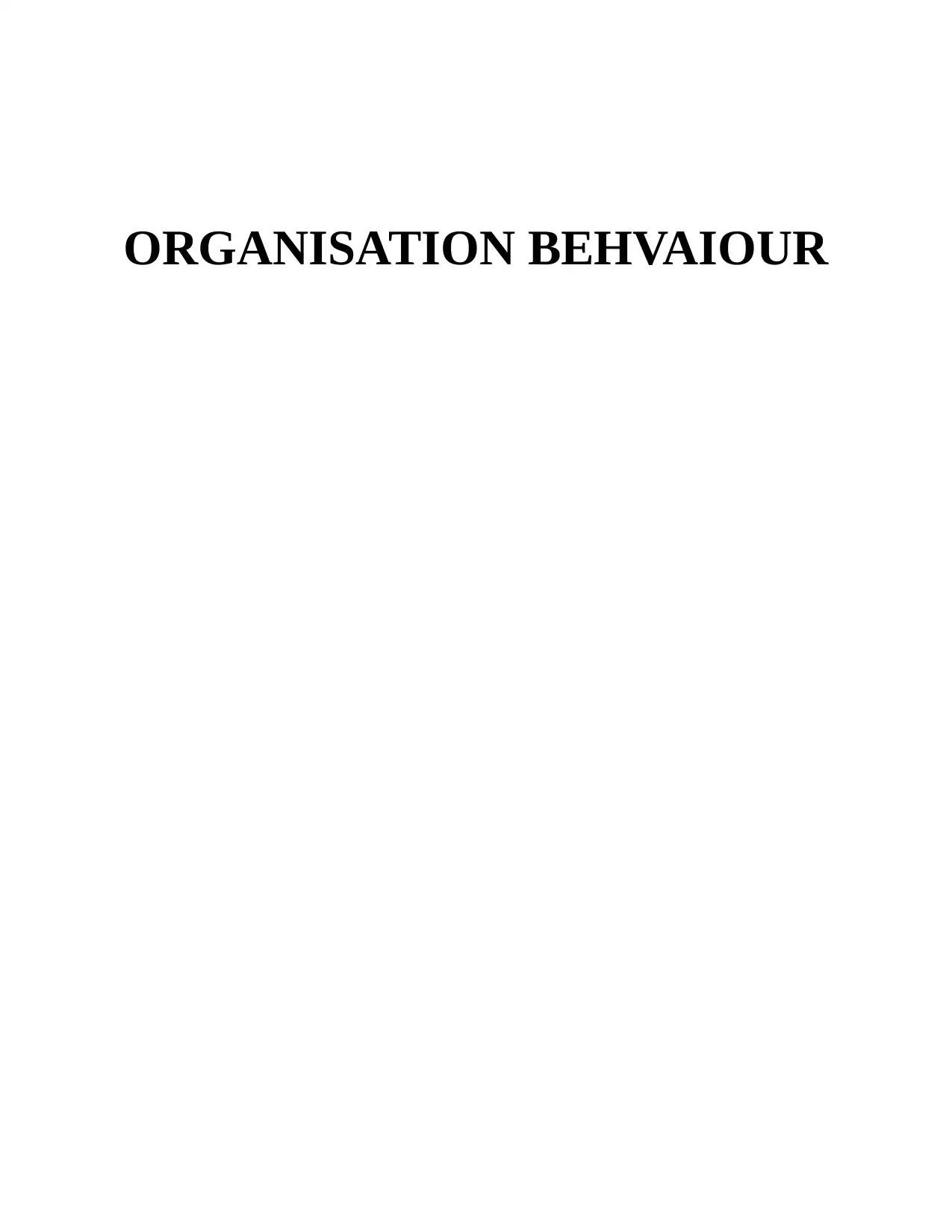
ORGANISATION BEHVAIOUR
Paraphrase This Document
Need a fresh take? Get an instant paraphrase of this document with our AI Paraphraser
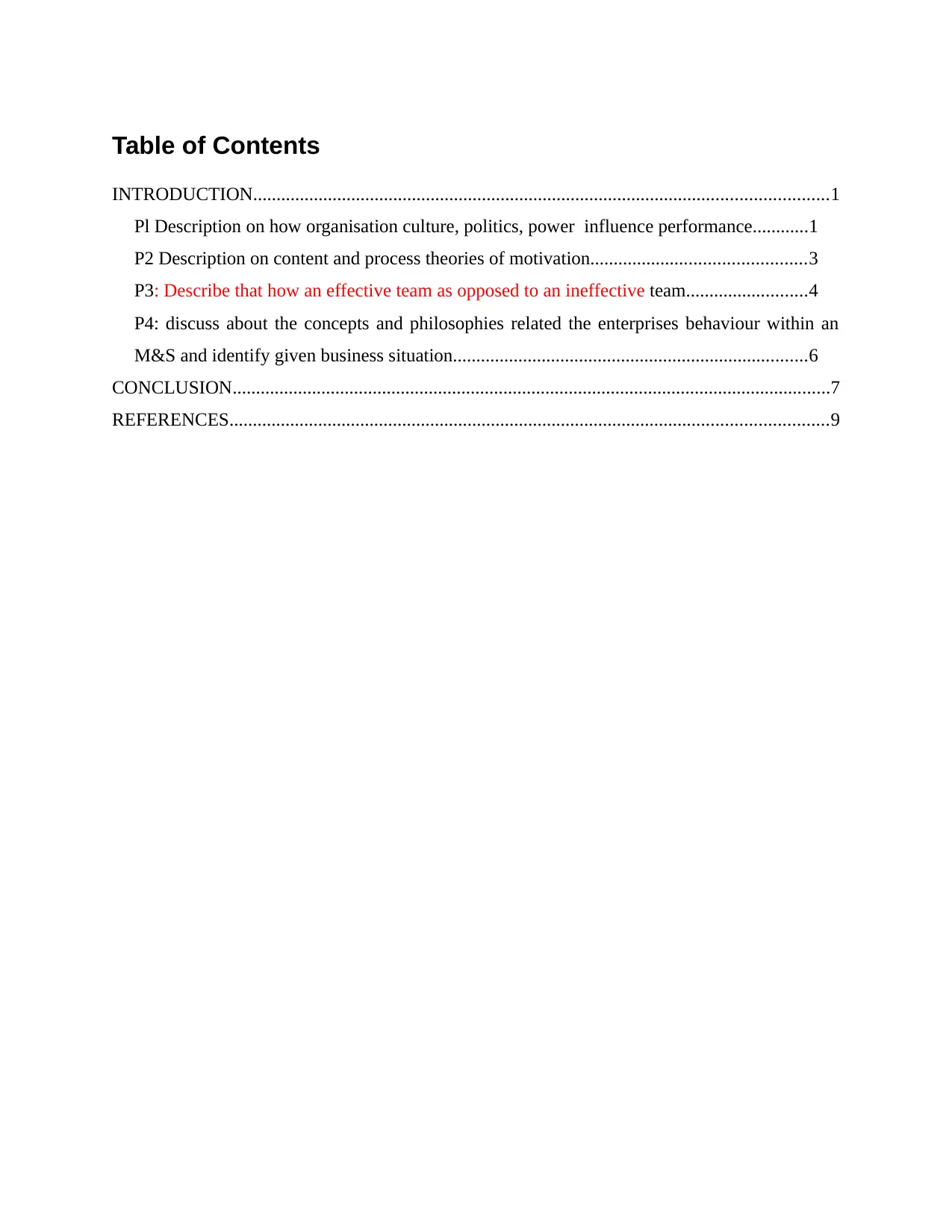
Table of Contents
INTRODUCTION...........................................................................................................................1
Pl Description on how organisation culture, politics, power influence performance............1
P2 Description on content and process theories of motivation..............................................3
P3: Describe that how an effective team as opposed to an ineffective team..........................4
P4: discuss about the concepts and philosophies related the enterprises behaviour within an
M&S and identify given business situation............................................................................6
CONCLUSION................................................................................................................................7
REFERENCES................................................................................................................................9
INTRODUCTION...........................................................................................................................1
Pl Description on how organisation culture, politics, power influence performance............1
P2 Description on content and process theories of motivation..............................................3
P3: Describe that how an effective team as opposed to an ineffective team..........................4
P4: discuss about the concepts and philosophies related the enterprises behaviour within an
M&S and identify given business situation............................................................................6
CONCLUSION................................................................................................................................7
REFERENCES................................................................................................................................9
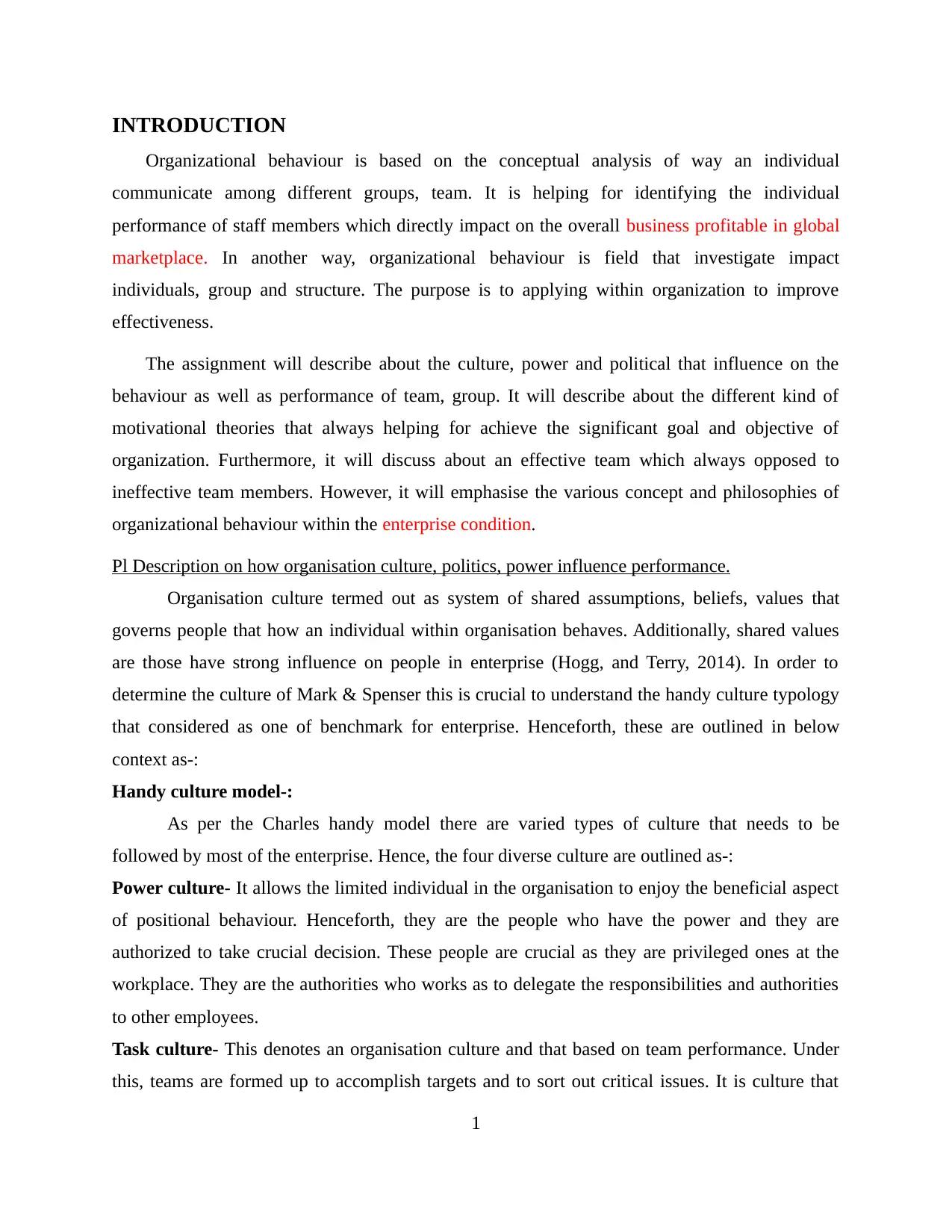
INTRODUCTION
Organizational behaviour is based on the conceptual analysis of way an individual
communicate among different groups, team. It is helping for identifying the individual
performance of staff members which directly impact on the overall business profitable in global
marketplace. In another way, organizational behaviour is field that investigate impact
individuals, group and structure. The purpose is to applying within organization to improve
effectiveness.
The assignment will describe about the culture, power and political that influence on the
behaviour as well as performance of team, group. It will describe about the different kind of
motivational theories that always helping for achieve the significant goal and objective of
organization. Furthermore, it will discuss about an effective team which always opposed to
ineffective team members. However, it will emphasise the various concept and philosophies of
organizational behaviour within the enterprise condition.
Pl Description on how organisation culture, politics, power influence performance.
Organisation culture termed out as system of shared assumptions, beliefs, values that
governs people that how an individual within organisation behaves. Additionally, shared values
are those have strong influence on people in enterprise (Hogg, and Terry, 2014). In order to
determine the culture of Mark & Spenser this is crucial to understand the handy culture typology
that considered as one of benchmark for enterprise. Henceforth, these are outlined in below
context as-:
Handy culture model-:
As per the Charles handy model there are varied types of culture that needs to be
followed by most of the enterprise. Hence, the four diverse culture are outlined as-:
Power culture- It allows the limited individual in the organisation to enjoy the beneficial aspect
of positional behaviour. Henceforth, they are the people who have the power and they are
authorized to take crucial decision. These people are crucial as they are privileged ones at the
workplace. They are the authorities who works as to delegate the responsibilities and authorities
to other employees.
Task culture- This denotes an organisation culture and that based on team performance. Under
this, teams are formed up to accomplish targets and to sort out critical issues. It is culture that
1
Organizational behaviour is based on the conceptual analysis of way an individual
communicate among different groups, team. It is helping for identifying the individual
performance of staff members which directly impact on the overall business profitable in global
marketplace. In another way, organizational behaviour is field that investigate impact
individuals, group and structure. The purpose is to applying within organization to improve
effectiveness.
The assignment will describe about the culture, power and political that influence on the
behaviour as well as performance of team, group. It will describe about the different kind of
motivational theories that always helping for achieve the significant goal and objective of
organization. Furthermore, it will discuss about an effective team which always opposed to
ineffective team members. However, it will emphasise the various concept and philosophies of
organizational behaviour within the enterprise condition.
Pl Description on how organisation culture, politics, power influence performance.
Organisation culture termed out as system of shared assumptions, beliefs, values that
governs people that how an individual within organisation behaves. Additionally, shared values
are those have strong influence on people in enterprise (Hogg, and Terry, 2014). In order to
determine the culture of Mark & Spenser this is crucial to understand the handy culture typology
that considered as one of benchmark for enterprise. Henceforth, these are outlined in below
context as-:
Handy culture model-:
As per the Charles handy model there are varied types of culture that needs to be
followed by most of the enterprise. Hence, the four diverse culture are outlined as-:
Power culture- It allows the limited individual in the organisation to enjoy the beneficial aspect
of positional behaviour. Henceforth, they are the people who have the power and they are
authorized to take crucial decision. These people are crucial as they are privileged ones at the
workplace. They are the authorities who works as to delegate the responsibilities and authorities
to other employees.
Task culture- This denotes an organisation culture and that based on team performance. Under
this, teams are formed up to accomplish targets and to sort out critical issues. It is culture that
1
⊘ This is a preview!⊘
Do you want full access?
Subscribe today to unlock all pages.

Trusted by 1+ million students worldwide
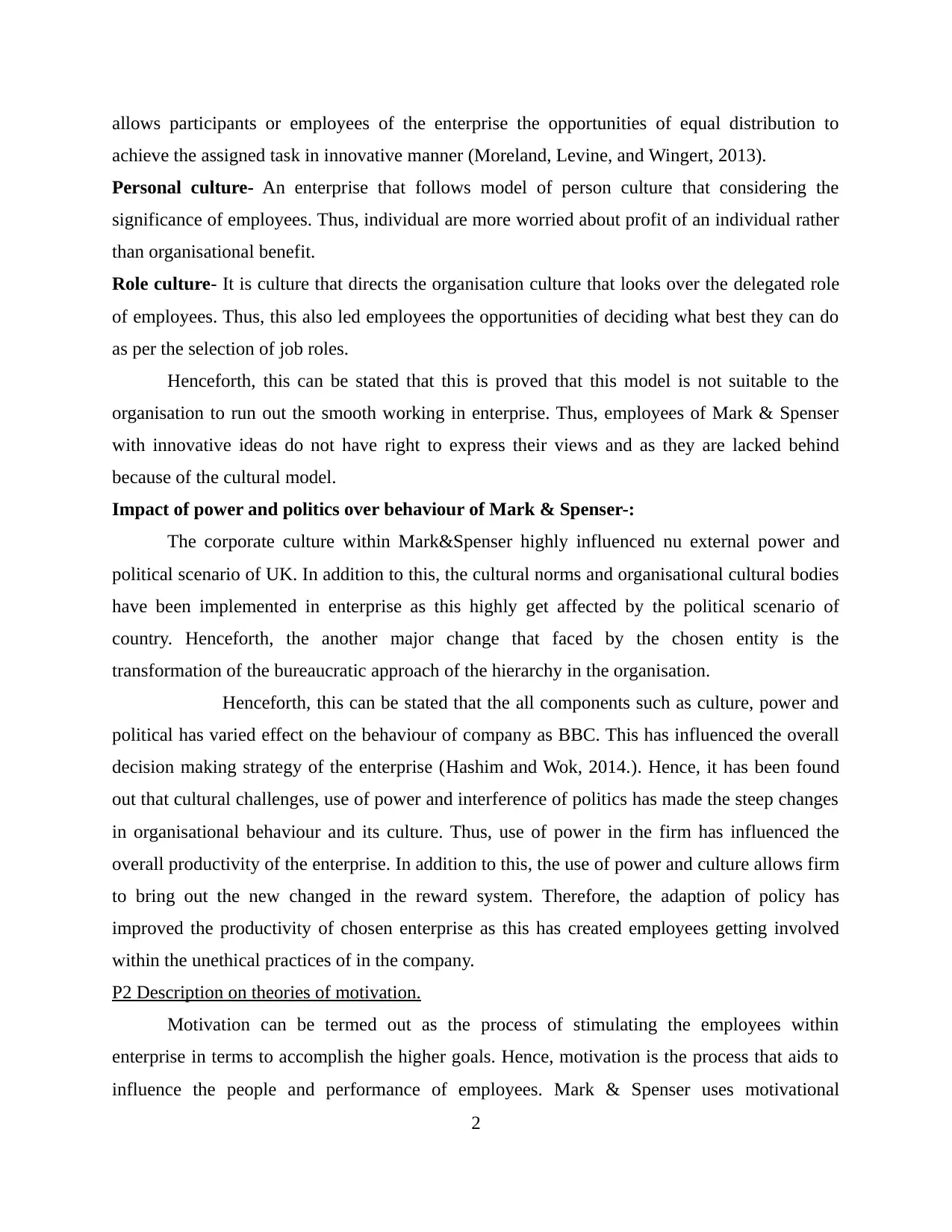
allows participants or employees of the enterprise the opportunities of equal distribution to
achieve the assigned task in innovative manner (Moreland, Levine, and Wingert, 2013).
Personal culture- An enterprise that follows model of person culture that considering the
significance of employees. Thus, individual are more worried about profit of an individual rather
than organisational benefit.
Role culture- It is culture that directs the organisation culture that looks over the delegated role
of employees. Thus, this also led employees the opportunities of deciding what best they can do
as per the selection of job roles.
Henceforth, this can be stated that this is proved that this model is not suitable to the
organisation to run out the smooth working in enterprise. Thus, employees of Mark & Spenser
with innovative ideas do not have right to express their views and as they are lacked behind
because of the cultural model.
Impact of power and politics over behaviour of Mark & Spenser-:
The corporate culture within Mark&Spenser highly influenced nu external power and
political scenario of UK. In addition to this, the cultural norms and organisational cultural bodies
have been implemented in enterprise as this highly get affected by the political scenario of
country. Henceforth, the another major change that faced by the chosen entity is the
transformation of the bureaucratic approach of the hierarchy in the organisation.
Henceforth, this can be stated that the all components such as culture, power and
political has varied effect on the behaviour of company as BBC. This has influenced the overall
decision making strategy of the enterprise (Hashim and Wok, 2014.). Hence, it has been found
out that cultural challenges, use of power and interference of politics has made the steep changes
in organisational behaviour and its culture. Thus, use of power in the firm has influenced the
overall productivity of the enterprise. In addition to this, the use of power and culture allows firm
to bring out the new changed in the reward system. Therefore, the adaption of policy has
improved the productivity of chosen enterprise as this has created employees getting involved
within the unethical practices of in the company.
P2 Description on theories of motivation.
Motivation can be termed out as the process of stimulating the employees within
enterprise in terms to accomplish the higher goals. Hence, motivation is the process that aids to
influence the people and performance of employees. Mark & Spenser uses motivational
2
achieve the assigned task in innovative manner (Moreland, Levine, and Wingert, 2013).
Personal culture- An enterprise that follows model of person culture that considering the
significance of employees. Thus, individual are more worried about profit of an individual rather
than organisational benefit.
Role culture- It is culture that directs the organisation culture that looks over the delegated role
of employees. Thus, this also led employees the opportunities of deciding what best they can do
as per the selection of job roles.
Henceforth, this can be stated that this is proved that this model is not suitable to the
organisation to run out the smooth working in enterprise. Thus, employees of Mark & Spenser
with innovative ideas do not have right to express their views and as they are lacked behind
because of the cultural model.
Impact of power and politics over behaviour of Mark & Spenser-:
The corporate culture within Mark&Spenser highly influenced nu external power and
political scenario of UK. In addition to this, the cultural norms and organisational cultural bodies
have been implemented in enterprise as this highly get affected by the political scenario of
country. Henceforth, the another major change that faced by the chosen entity is the
transformation of the bureaucratic approach of the hierarchy in the organisation.
Henceforth, this can be stated that the all components such as culture, power and
political has varied effect on the behaviour of company as BBC. This has influenced the overall
decision making strategy of the enterprise (Hashim and Wok, 2014.). Hence, it has been found
out that cultural challenges, use of power and interference of politics has made the steep changes
in organisational behaviour and its culture. Thus, use of power in the firm has influenced the
overall productivity of the enterprise. In addition to this, the use of power and culture allows firm
to bring out the new changed in the reward system. Therefore, the adaption of policy has
improved the productivity of chosen enterprise as this has created employees getting involved
within the unethical practices of in the company.
P2 Description on theories of motivation.
Motivation can be termed out as the process of stimulating the employees within
enterprise in terms to accomplish the higher goals. Hence, motivation is the process that aids to
influence the people and performance of employees. Mark & Spenser uses motivational
2
Paraphrase This Document
Need a fresh take? Get an instant paraphrase of this document with our AI Paraphraser
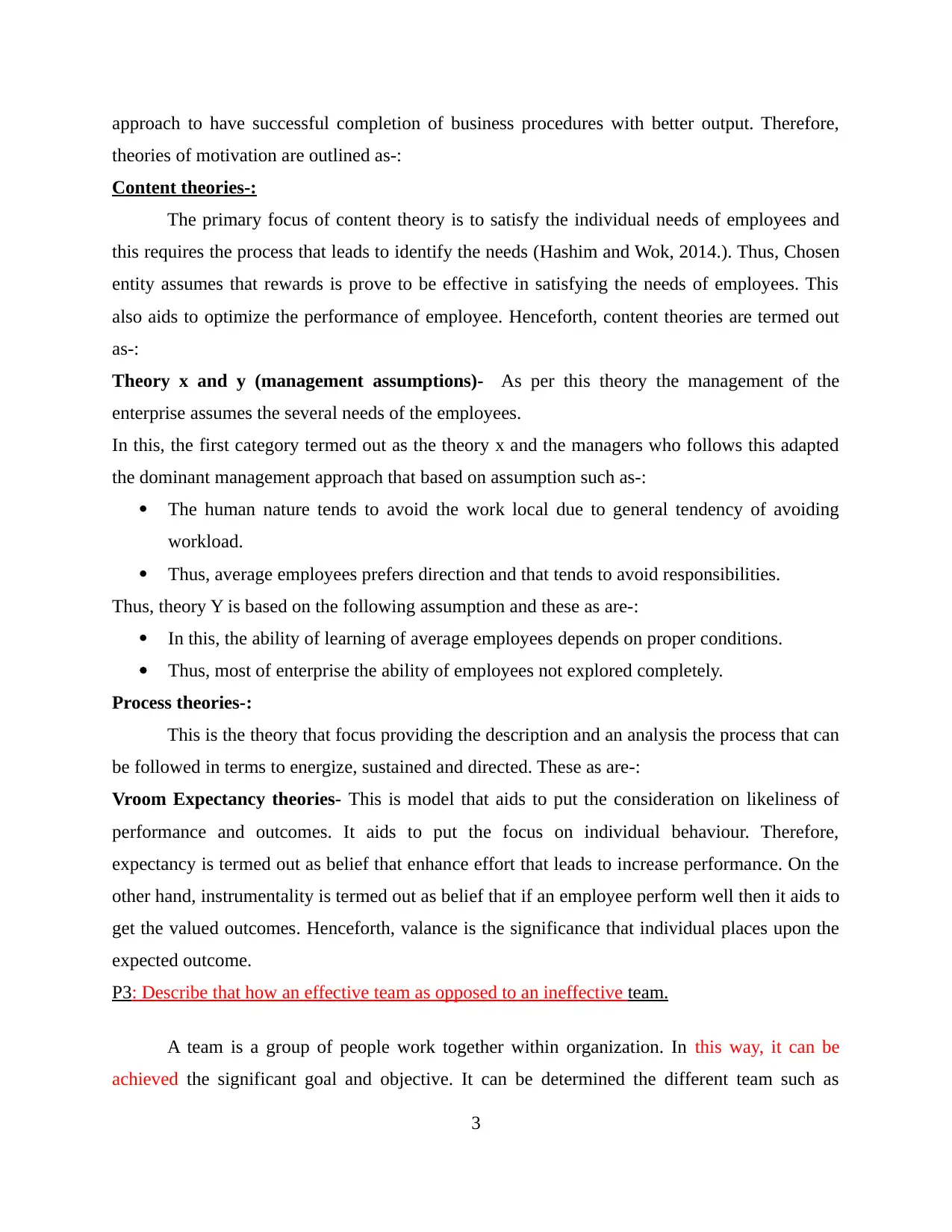
approach to have successful completion of business procedures with better output. Therefore,
theories of motivation are outlined as-:
Content theories-:
The primary focus of content theory is to satisfy the individual needs of employees and
this requires the process that leads to identify the needs (Hashim and Wok, 2014.). Thus, Chosen
entity assumes that rewards is prove to be effective in satisfying the needs of employees. This
also aids to optimize the performance of employee. Henceforth, content theories are termed out
as-:
Theory x and y (management assumptions)- As per this theory the management of the
enterprise assumes the several needs of the employees.
In this, the first category termed out as the theory x and the managers who follows this adapted
the dominant management approach that based on assumption such as-:
The human nature tends to avoid the work local due to general tendency of avoiding
workload.
Thus, average employees prefers direction and that tends to avoid responsibilities.
Thus, theory Y is based on the following assumption and these as are-:
In this, the ability of learning of average employees depends on proper conditions.
Thus, most of enterprise the ability of employees not explored completely.
Process theories-:
This is the theory that focus providing the description and an analysis the process that can
be followed in terms to energize, sustained and directed. These as are-:
Vroom Expectancy theories- This is model that aids to put the consideration on likeliness of
performance and outcomes. It aids to put the focus on individual behaviour. Therefore,
expectancy is termed out as belief that enhance effort that leads to increase performance. On the
other hand, instrumentality is termed out as belief that if an employee perform well then it aids to
get the valued outcomes. Henceforth, valance is the significance that individual places upon the
expected outcome.
P3: Describe that how an effective team as opposed to an ineffective team.
A team is a group of people work together within organization. In this way, it can be
achieved the significant goal and objective. It can be determined the different team such as
3
theories of motivation are outlined as-:
Content theories-:
The primary focus of content theory is to satisfy the individual needs of employees and
this requires the process that leads to identify the needs (Hashim and Wok, 2014.). Thus, Chosen
entity assumes that rewards is prove to be effective in satisfying the needs of employees. This
also aids to optimize the performance of employee. Henceforth, content theories are termed out
as-:
Theory x and y (management assumptions)- As per this theory the management of the
enterprise assumes the several needs of the employees.
In this, the first category termed out as the theory x and the managers who follows this adapted
the dominant management approach that based on assumption such as-:
The human nature tends to avoid the work local due to general tendency of avoiding
workload.
Thus, average employees prefers direction and that tends to avoid responsibilities.
Thus, theory Y is based on the following assumption and these as are-:
In this, the ability of learning of average employees depends on proper conditions.
Thus, most of enterprise the ability of employees not explored completely.
Process theories-:
This is the theory that focus providing the description and an analysis the process that can
be followed in terms to energize, sustained and directed. These as are-:
Vroom Expectancy theories- This is model that aids to put the consideration on likeliness of
performance and outcomes. It aids to put the focus on individual behaviour. Therefore,
expectancy is termed out as belief that enhance effort that leads to increase performance. On the
other hand, instrumentality is termed out as belief that if an employee perform well then it aids to
get the valued outcomes. Henceforth, valance is the significance that individual places upon the
expected outcome.
P3: Describe that how an effective team as opposed to an ineffective team.
A team is a group of people work together within organization. In this way, it can be
achieved the significant goal and objective. It can be determined the different team such as
3
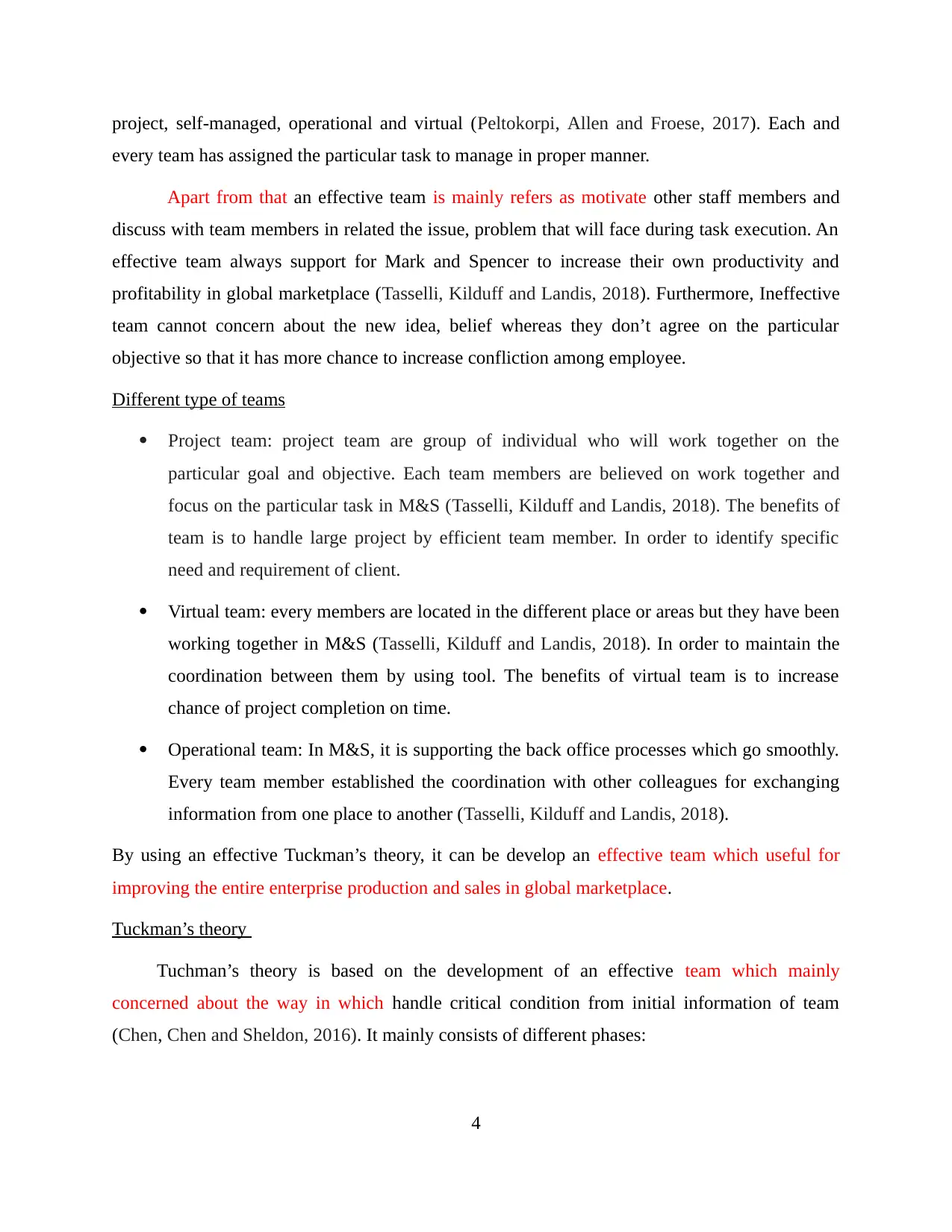
project, self-managed, operational and virtual (Peltokorpi, Allen and Froese, 2017). Each and
every team has assigned the particular task to manage in proper manner.
Apart from that an effective team is mainly refers as motivate other staff members and
discuss with team members in related the issue, problem that will face during task execution. An
effective team always support for Mark and Spencer to increase their own productivity and
profitability in global marketplace (Tasselli, Kilduff and Landis, 2018). Furthermore, Ineffective
team cannot concern about the new idea, belief whereas they don’t agree on the particular
objective so that it has more chance to increase confliction among employee.
Different type of teams
Project team: project team are group of individual who will work together on the
particular goal and objective. Each team members are believed on work together and
focus on the particular task in M&S (Tasselli, Kilduff and Landis, 2018). The benefits of
team is to handle large project by efficient team member. In order to identify specific
need and requirement of client.
Virtual team: every members are located in the different place or areas but they have been
working together in M&S (Tasselli, Kilduff and Landis, 2018). In order to maintain the
coordination between them by using tool. The benefits of virtual team is to increase
chance of project completion on time.
Operational team: In M&S, it is supporting the back office processes which go smoothly.
Every team member established the coordination with other colleagues for exchanging
information from one place to another (Tasselli, Kilduff and Landis, 2018).
By using an effective Tuckman’s theory, it can be develop an effective team which useful for
improving the entire enterprise production and sales in global marketplace.
Tuckman’s theory
Tuchman’s theory is based on the development of an effective team which mainly
concerned about the way in which handle critical condition from initial information of team
(Chen, Chen and Sheldon, 2016). It mainly consists of different phases:
4
every team has assigned the particular task to manage in proper manner.
Apart from that an effective team is mainly refers as motivate other staff members and
discuss with team members in related the issue, problem that will face during task execution. An
effective team always support for Mark and Spencer to increase their own productivity and
profitability in global marketplace (Tasselli, Kilduff and Landis, 2018). Furthermore, Ineffective
team cannot concern about the new idea, belief whereas they don’t agree on the particular
objective so that it has more chance to increase confliction among employee.
Different type of teams
Project team: project team are group of individual who will work together on the
particular goal and objective. Each team members are believed on work together and
focus on the particular task in M&S (Tasselli, Kilduff and Landis, 2018). The benefits of
team is to handle large project by efficient team member. In order to identify specific
need and requirement of client.
Virtual team: every members are located in the different place or areas but they have been
working together in M&S (Tasselli, Kilduff and Landis, 2018). In order to maintain the
coordination between them by using tool. The benefits of virtual team is to increase
chance of project completion on time.
Operational team: In M&S, it is supporting the back office processes which go smoothly.
Every team member established the coordination with other colleagues for exchanging
information from one place to another (Tasselli, Kilduff and Landis, 2018).
By using an effective Tuckman’s theory, it can be develop an effective team which useful for
improving the entire enterprise production and sales in global marketplace.
Tuckman’s theory
Tuchman’s theory is based on the development of an effective team which mainly
concerned about the way in which handle critical condition from initial information of team
(Chen, Chen and Sheldon, 2016). It mainly consists of different phases:
4
⊘ This is a preview!⊘
Do you want full access?
Subscribe today to unlock all pages.

Trusted by 1+ million students worldwide
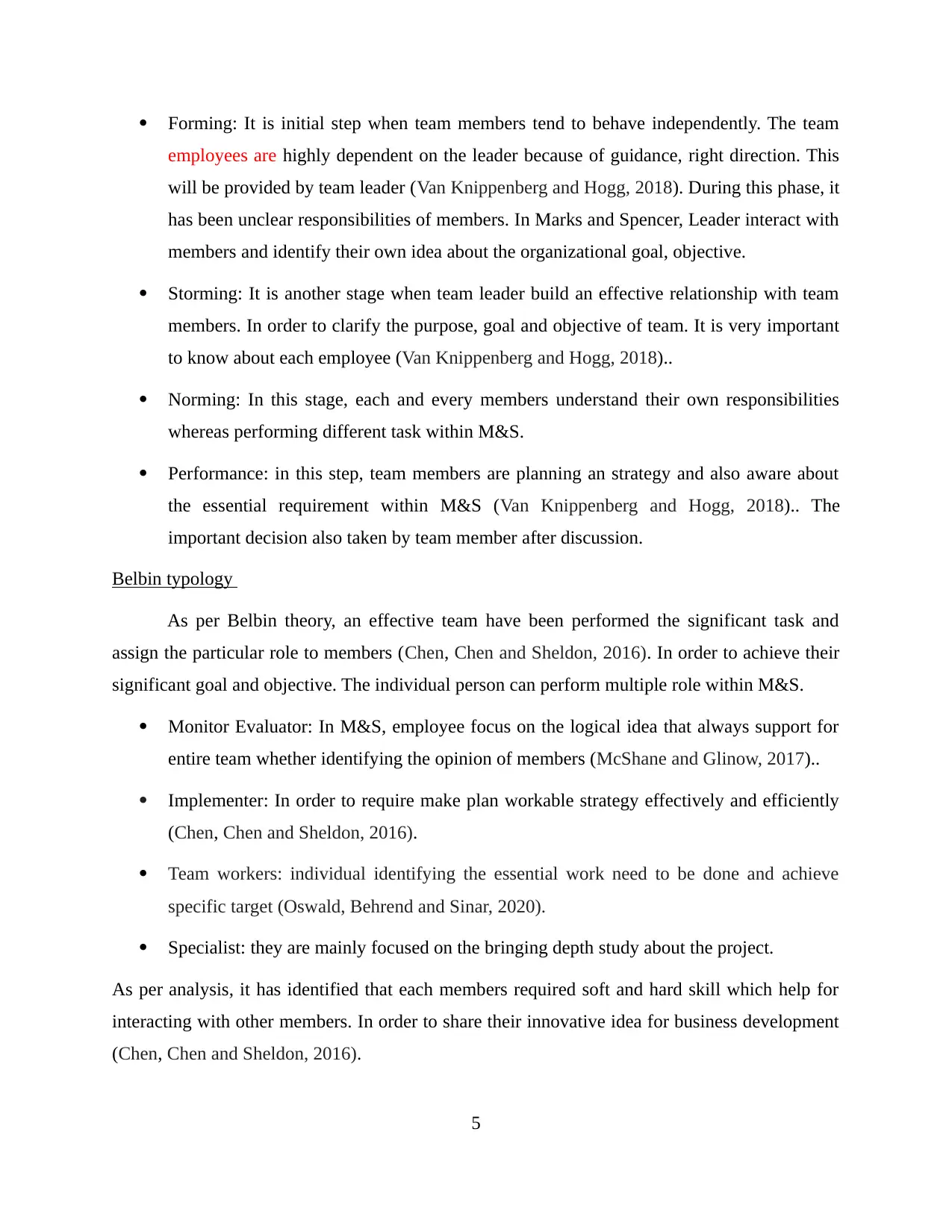
Forming: It is initial step when team members tend to behave independently. The team
employees are highly dependent on the leader because of guidance, right direction. This
will be provided by team leader (Van Knippenberg and Hogg, 2018). During this phase, it
has been unclear responsibilities of members. In Marks and Spencer, Leader interact with
members and identify their own idea about the organizational goal, objective.
Storming: It is another stage when team leader build an effective relationship with team
members. In order to clarify the purpose, goal and objective of team. It is very important
to know about each employee (Van Knippenberg and Hogg, 2018)..
Norming: In this stage, each and every members understand their own responsibilities
whereas performing different task within M&S.
Performance: in this step, team members are planning an strategy and also aware about
the essential requirement within M&S (Van Knippenberg and Hogg, 2018).. The
important decision also taken by team member after discussion.
Belbin typology
As per Belbin theory, an effective team have been performed the significant task and
assign the particular role to members (Chen, Chen and Sheldon, 2016). In order to achieve their
significant goal and objective. The individual person can perform multiple role within M&S.
Monitor Evaluator: In M&S, employee focus on the logical idea that always support for
entire team whether identifying the opinion of members (McShane and Glinow, 2017)..
Implementer: In order to require make plan workable strategy effectively and efficiently
(Chen, Chen and Sheldon, 2016).
Team workers: individual identifying the essential work need to be done and achieve
specific target (Oswald, Behrend and Sinar, 2020).
Specialist: they are mainly focused on the bringing depth study about the project.
As per analysis, it has identified that each members required soft and hard skill which help for
interacting with other members. In order to share their innovative idea for business development
(Chen, Chen and Sheldon, 2016).
5
employees are highly dependent on the leader because of guidance, right direction. This
will be provided by team leader (Van Knippenberg and Hogg, 2018). During this phase, it
has been unclear responsibilities of members. In Marks and Spencer, Leader interact with
members and identify their own idea about the organizational goal, objective.
Storming: It is another stage when team leader build an effective relationship with team
members. In order to clarify the purpose, goal and objective of team. It is very important
to know about each employee (Van Knippenberg and Hogg, 2018)..
Norming: In this stage, each and every members understand their own responsibilities
whereas performing different task within M&S.
Performance: in this step, team members are planning an strategy and also aware about
the essential requirement within M&S (Van Knippenberg and Hogg, 2018).. The
important decision also taken by team member after discussion.
Belbin typology
As per Belbin theory, an effective team have been performed the significant task and
assign the particular role to members (Chen, Chen and Sheldon, 2016). In order to achieve their
significant goal and objective. The individual person can perform multiple role within M&S.
Monitor Evaluator: In M&S, employee focus on the logical idea that always support for
entire team whether identifying the opinion of members (McShane and Glinow, 2017)..
Implementer: In order to require make plan workable strategy effectively and efficiently
(Chen, Chen and Sheldon, 2016).
Team workers: individual identifying the essential work need to be done and achieve
specific target (Oswald, Behrend and Sinar, 2020).
Specialist: they are mainly focused on the bringing depth study about the project.
As per analysis, it has identified that each members required soft and hard skill which help for
interacting with other members. In order to share their innovative idea for business development
(Chen, Chen and Sheldon, 2016).
5
Paraphrase This Document
Need a fresh take? Get an instant paraphrase of this document with our AI Paraphraser
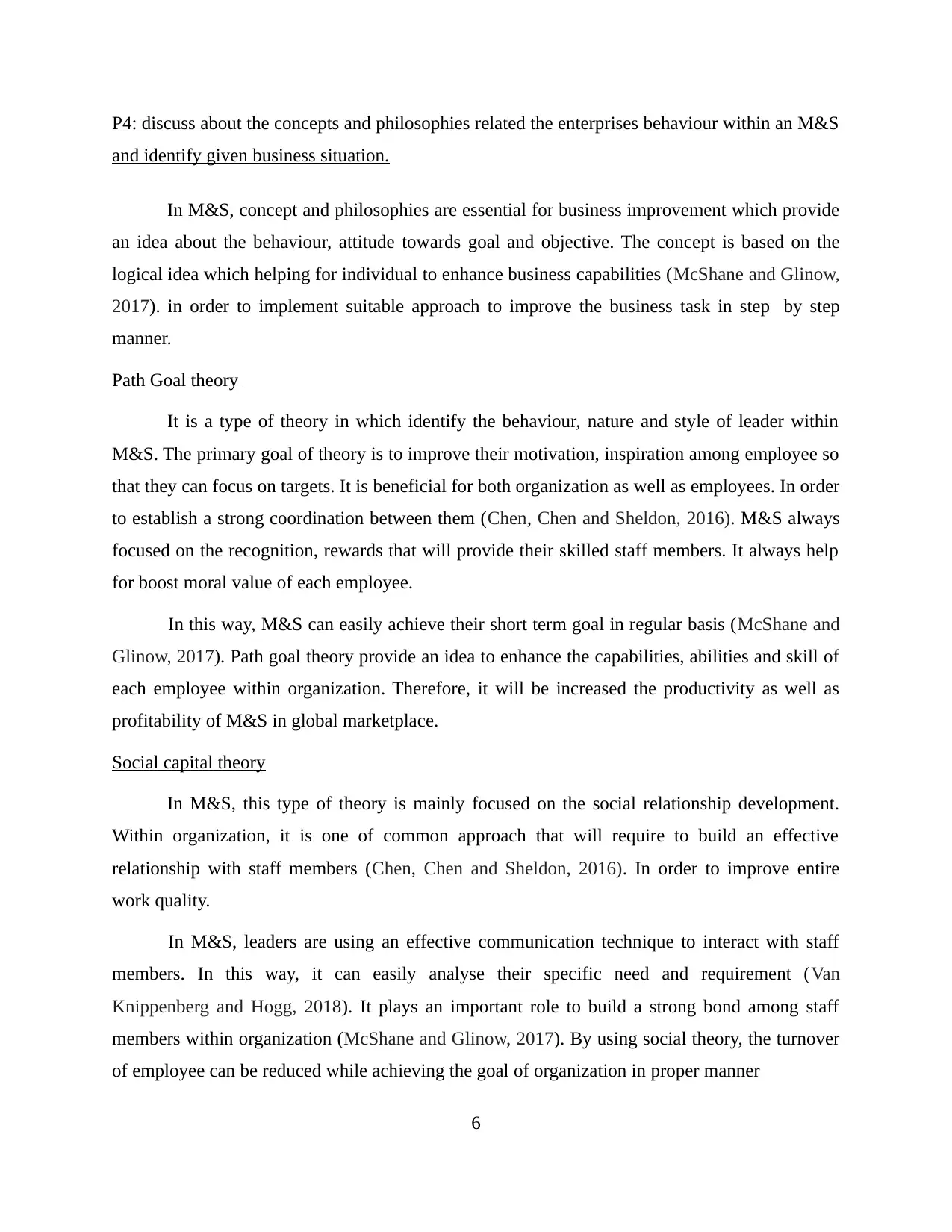
P4: discuss about the concepts and philosophies related the enterprises behaviour within an M&S
and identify given business situation.
In M&S, concept and philosophies are essential for business improvement which provide
an idea about the behaviour, attitude towards goal and objective. The concept is based on the
logical idea which helping for individual to enhance business capabilities (McShane and Glinow,
2017). in order to implement suitable approach to improve the business task in step by step
manner.
Path Goal theory
It is a type of theory in which identify the behaviour, nature and style of leader within
M&S. The primary goal of theory is to improve their motivation, inspiration among employee so
that they can focus on targets. It is beneficial for both organization as well as employees. In order
to establish a strong coordination between them (Chen, Chen and Sheldon, 2016). M&S always
focused on the recognition, rewards that will provide their skilled staff members. It always help
for boost moral value of each employee.
In this way, M&S can easily achieve their short term goal in regular basis (McShane and
Glinow, 2017). Path goal theory provide an idea to enhance the capabilities, abilities and skill of
each employee within organization. Therefore, it will be increased the productivity as well as
profitability of M&S in global marketplace.
Social capital theory
In M&S, this type of theory is mainly focused on the social relationship development.
Within organization, it is one of common approach that will require to build an effective
relationship with staff members (Chen, Chen and Sheldon, 2016). In order to improve entire
work quality.
In M&S, leaders are using an effective communication technique to interact with staff
members. In this way, it can easily analyse their specific need and requirement (Van
Knippenberg and Hogg, 2018). It plays an important role to build a strong bond among staff
members within organization (McShane and Glinow, 2017). By using social theory, the turnover
of employee can be reduced while achieving the goal of organization in proper manner
6
and identify given business situation.
In M&S, concept and philosophies are essential for business improvement which provide
an idea about the behaviour, attitude towards goal and objective. The concept is based on the
logical idea which helping for individual to enhance business capabilities (McShane and Glinow,
2017). in order to implement suitable approach to improve the business task in step by step
manner.
Path Goal theory
It is a type of theory in which identify the behaviour, nature and style of leader within
M&S. The primary goal of theory is to improve their motivation, inspiration among employee so
that they can focus on targets. It is beneficial for both organization as well as employees. In order
to establish a strong coordination between them (Chen, Chen and Sheldon, 2016). M&S always
focused on the recognition, rewards that will provide their skilled staff members. It always help
for boost moral value of each employee.
In this way, M&S can easily achieve their short term goal in regular basis (McShane and
Glinow, 2017). Path goal theory provide an idea to enhance the capabilities, abilities and skill of
each employee within organization. Therefore, it will be increased the productivity as well as
profitability of M&S in global marketplace.
Social capital theory
In M&S, this type of theory is mainly focused on the social relationship development.
Within organization, it is one of common approach that will require to build an effective
relationship with staff members (Chen, Chen and Sheldon, 2016). In order to improve entire
work quality.
In M&S, leaders are using an effective communication technique to interact with staff
members. In this way, it can easily analyse their specific need and requirement (Van
Knippenberg and Hogg, 2018). It plays an important role to build a strong bond among staff
members within organization (McShane and Glinow, 2017). By using social theory, the turnover
of employee can be reduced while achieving the goal of organization in proper manner
6
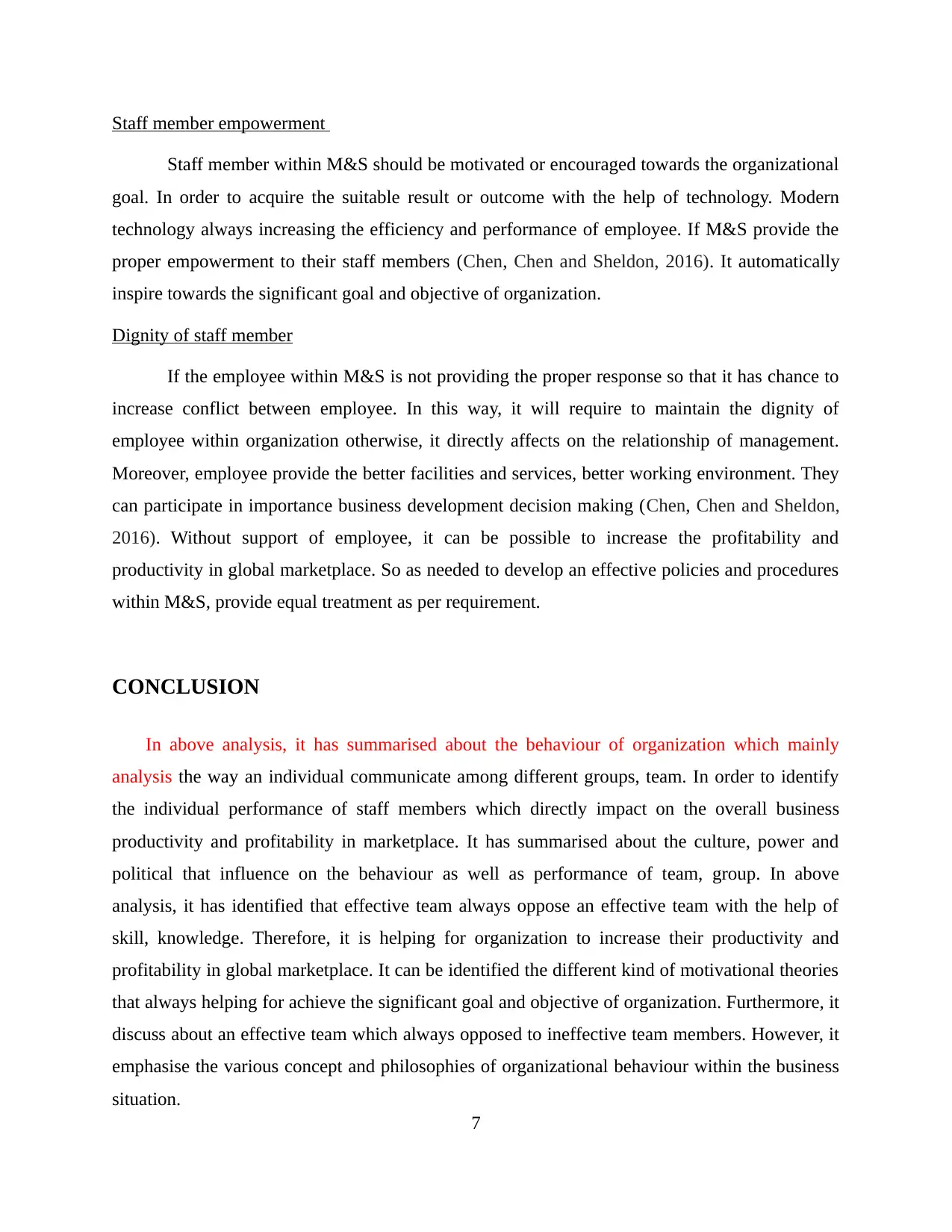
Staff member empowerment
Staff member within M&S should be motivated or encouraged towards the organizational
goal. In order to acquire the suitable result or outcome with the help of technology. Modern
technology always increasing the efficiency and performance of employee. If M&S provide the
proper empowerment to their staff members (Chen, Chen and Sheldon, 2016). It automatically
inspire towards the significant goal and objective of organization.
Dignity of staff member
If the employee within M&S is not providing the proper response so that it has chance to
increase conflict between employee. In this way, it will require to maintain the dignity of
employee within organization otherwise, it directly affects on the relationship of management.
Moreover, employee provide the better facilities and services, better working environment. They
can participate in importance business development decision making (Chen, Chen and Sheldon,
2016). Without support of employee, it can be possible to increase the profitability and
productivity in global marketplace. So as needed to develop an effective policies and procedures
within M&S, provide equal treatment as per requirement.
CONCLUSION
In above analysis, it has summarised about the behaviour of organization which mainly
analysis the way an individual communicate among different groups, team. In order to identify
the individual performance of staff members which directly impact on the overall business
productivity and profitability in marketplace. It has summarised about the culture, power and
political that influence on the behaviour as well as performance of team, group. In above
analysis, it has identified that effective team always oppose an effective team with the help of
skill, knowledge. Therefore, it is helping for organization to increase their productivity and
profitability in global marketplace. It can be identified the different kind of motivational theories
that always helping for achieve the significant goal and objective of organization. Furthermore, it
discuss about an effective team which always opposed to ineffective team members. However, it
emphasise the various concept and philosophies of organizational behaviour within the business
situation.
7
Staff member within M&S should be motivated or encouraged towards the organizational
goal. In order to acquire the suitable result or outcome with the help of technology. Modern
technology always increasing the efficiency and performance of employee. If M&S provide the
proper empowerment to their staff members (Chen, Chen and Sheldon, 2016). It automatically
inspire towards the significant goal and objective of organization.
Dignity of staff member
If the employee within M&S is not providing the proper response so that it has chance to
increase conflict between employee. In this way, it will require to maintain the dignity of
employee within organization otherwise, it directly affects on the relationship of management.
Moreover, employee provide the better facilities and services, better working environment. They
can participate in importance business development decision making (Chen, Chen and Sheldon,
2016). Without support of employee, it can be possible to increase the profitability and
productivity in global marketplace. So as needed to develop an effective policies and procedures
within M&S, provide equal treatment as per requirement.
CONCLUSION
In above analysis, it has summarised about the behaviour of organization which mainly
analysis the way an individual communicate among different groups, team. In order to identify
the individual performance of staff members which directly impact on the overall business
productivity and profitability in marketplace. It has summarised about the culture, power and
political that influence on the behaviour as well as performance of team, group. In above
analysis, it has identified that effective team always oppose an effective team with the help of
skill, knowledge. Therefore, it is helping for organization to increase their productivity and
profitability in global marketplace. It can be identified the different kind of motivational theories
that always helping for achieve the significant goal and objective of organization. Furthermore, it
discuss about an effective team which always opposed to ineffective team members. However, it
emphasise the various concept and philosophies of organizational behaviour within the business
situation.
7
⊘ This is a preview!⊘
Do you want full access?
Subscribe today to unlock all pages.

Trusted by 1+ million students worldwide

8
Paraphrase This Document
Need a fresh take? Get an instant paraphrase of this document with our AI Paraphraser
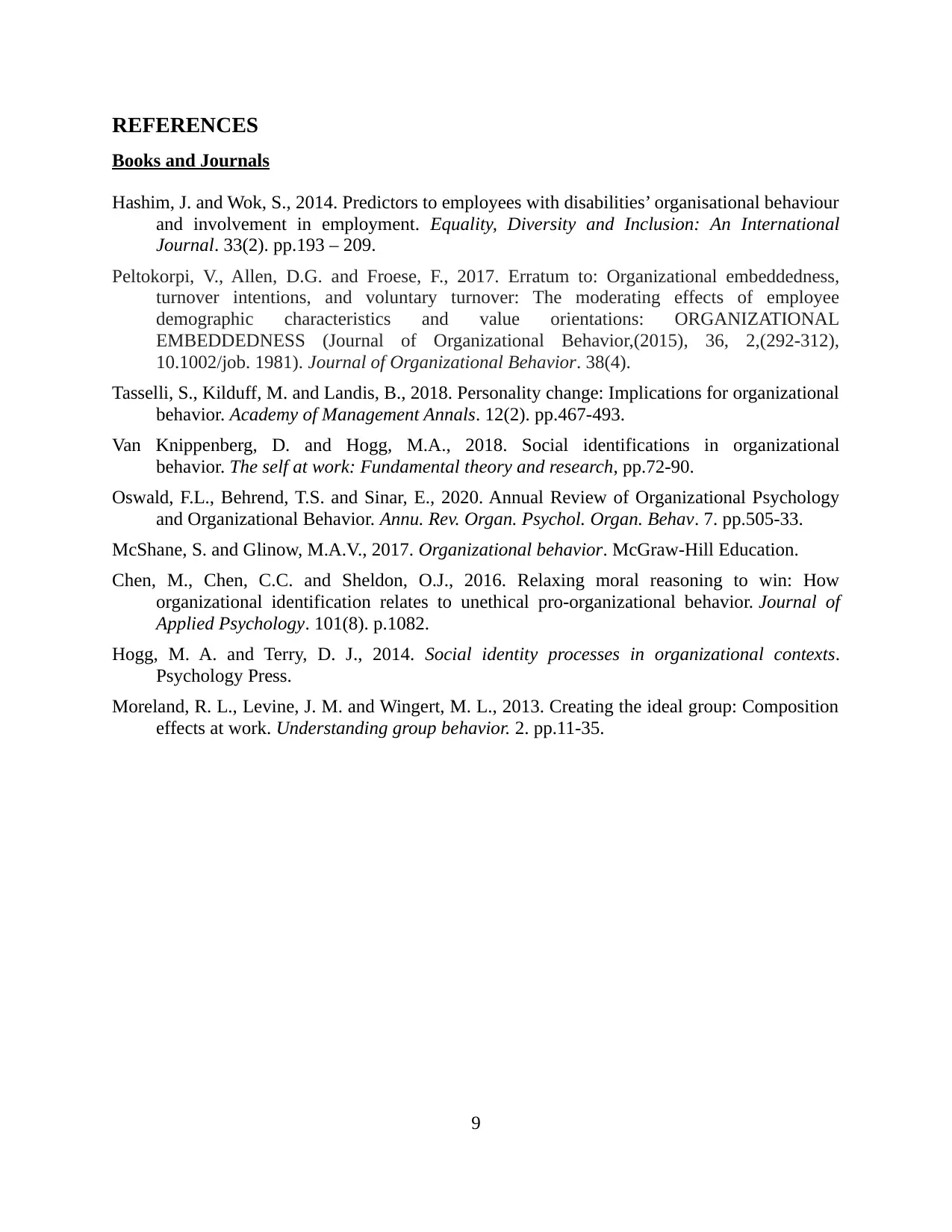
REFERENCES
Books and Journals
Hashim, J. and Wok, S., 2014. Predictors to employees with disabilities’ organisational behaviour
and involvement in employment. Equality, Diversity and Inclusion: An International
Journal. 33(2). pp.193 – 209.
Peltokorpi, V., Allen, D.G. and Froese, F., 2017. Erratum to: Organizational embeddedness,
turnover intentions, and voluntary turnover: The moderating effects of employee
demographic characteristics and value orientations: ORGANIZATIONAL
EMBEDDEDNESS (Journal of Organizational Behavior,(2015), 36, 2,(292-312),
10.1002/job. 1981). Journal of Organizational Behavior. 38(4).
Tasselli, S., Kilduff, M. and Landis, B., 2018. Personality change: Implications for organizational
behavior. Academy of Management Annals. 12(2). pp.467-493.
Van Knippenberg, D. and Hogg, M.A., 2018. Social identifications in organizational
behavior. The self at work: Fundamental theory and research, pp.72-90.
Oswald, F.L., Behrend, T.S. and Sinar, E., 2020. Annual Review of Organizational Psychology
and Organizational Behavior. Annu. Rev. Organ. Psychol. Organ. Behav. 7. pp.505-33.
McShane, S. and Glinow, M.A.V., 2017. Organizational behavior. McGraw-Hill Education.
Chen, M., Chen, C.C. and Sheldon, O.J., 2016. Relaxing moral reasoning to win: How
organizational identification relates to unethical pro-organizational behavior. Journal of
Applied Psychology. 101(8). p.1082.
Hogg, M. A. and Terry, D. J., 2014. Social identity processes in organizational contexts.
Psychology Press.
Moreland, R. L., Levine, J. M. and Wingert, M. L., 2013. Creating the ideal group: Composition
effects at work. Understanding group behavior. 2. pp.11-35.
9
Books and Journals
Hashim, J. and Wok, S., 2014. Predictors to employees with disabilities’ organisational behaviour
and involvement in employment. Equality, Diversity and Inclusion: An International
Journal. 33(2). pp.193 – 209.
Peltokorpi, V., Allen, D.G. and Froese, F., 2017. Erratum to: Organizational embeddedness,
turnover intentions, and voluntary turnover: The moderating effects of employee
demographic characteristics and value orientations: ORGANIZATIONAL
EMBEDDEDNESS (Journal of Organizational Behavior,(2015), 36, 2,(292-312),
10.1002/job. 1981). Journal of Organizational Behavior. 38(4).
Tasselli, S., Kilduff, M. and Landis, B., 2018. Personality change: Implications for organizational
behavior. Academy of Management Annals. 12(2). pp.467-493.
Van Knippenberg, D. and Hogg, M.A., 2018. Social identifications in organizational
behavior. The self at work: Fundamental theory and research, pp.72-90.
Oswald, F.L., Behrend, T.S. and Sinar, E., 2020. Annual Review of Organizational Psychology
and Organizational Behavior. Annu. Rev. Organ. Psychol. Organ. Behav. 7. pp.505-33.
McShane, S. and Glinow, M.A.V., 2017. Organizational behavior. McGraw-Hill Education.
Chen, M., Chen, C.C. and Sheldon, O.J., 2016. Relaxing moral reasoning to win: How
organizational identification relates to unethical pro-organizational behavior. Journal of
Applied Psychology. 101(8). p.1082.
Hogg, M. A. and Terry, D. J., 2014. Social identity processes in organizational contexts.
Psychology Press.
Moreland, R. L., Levine, J. M. and Wingert, M. L., 2013. Creating the ideal group: Composition
effects at work. Understanding group behavior. 2. pp.11-35.
9
1 out of 11
Related Documents
Your All-in-One AI-Powered Toolkit for Academic Success.
+13062052269
info@desklib.com
Available 24*7 on WhatsApp / Email
![[object Object]](/_next/static/media/star-bottom.7253800d.svg)
Unlock your academic potential
Copyright © 2020–2025 A2Z Services. All Rights Reserved. Developed and managed by ZUCOL.




